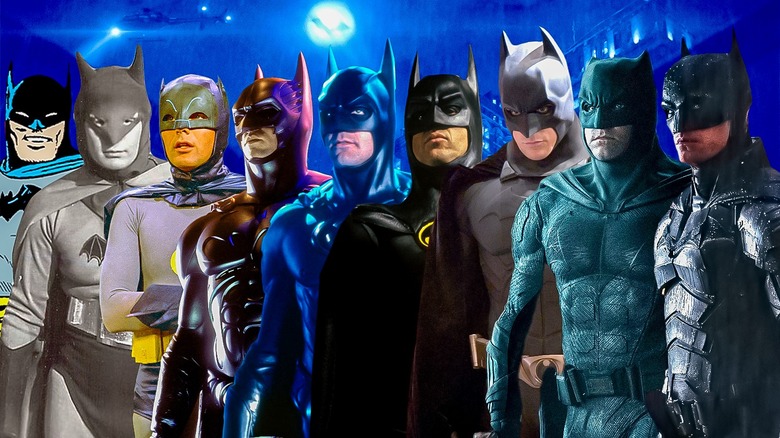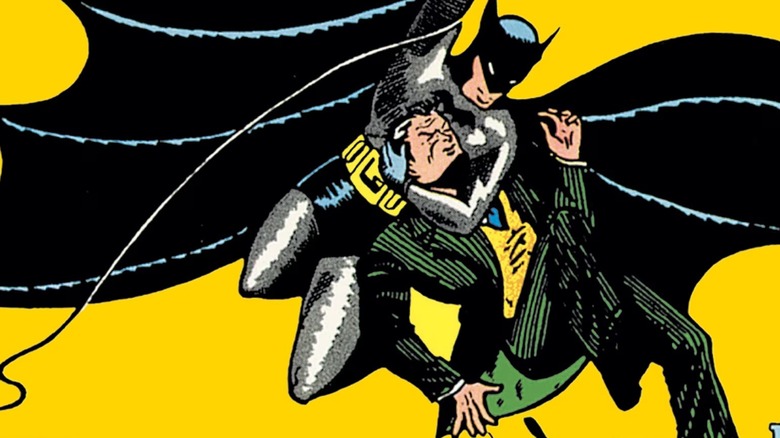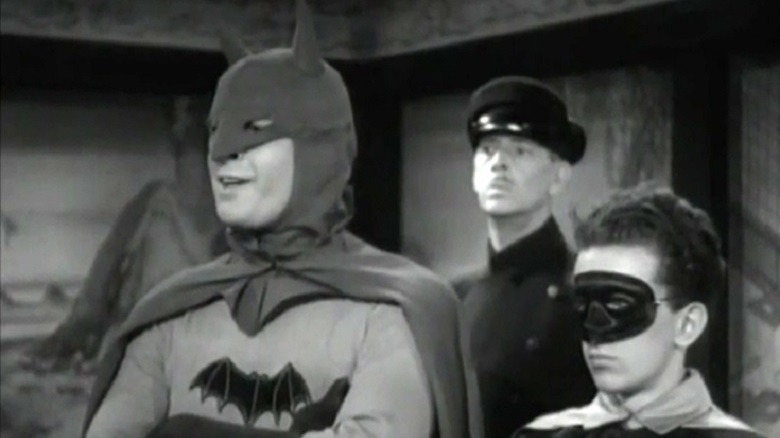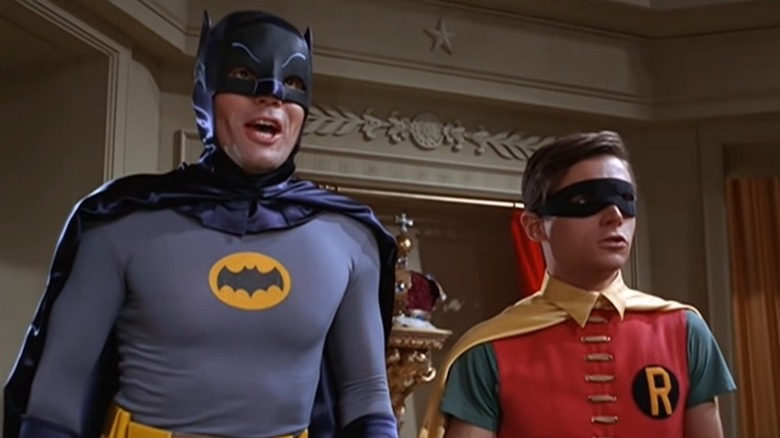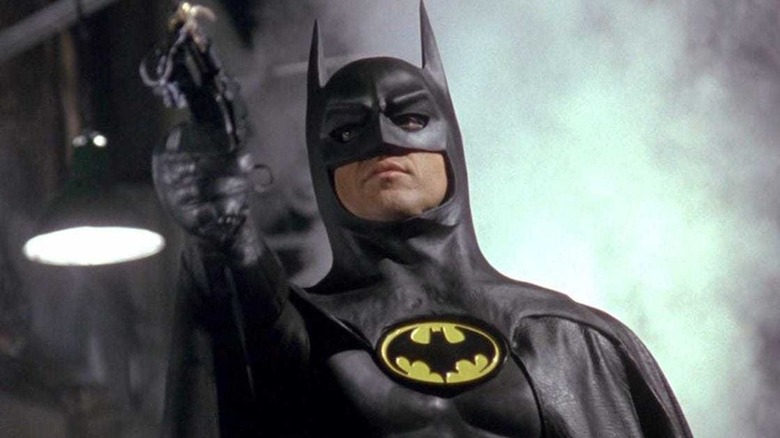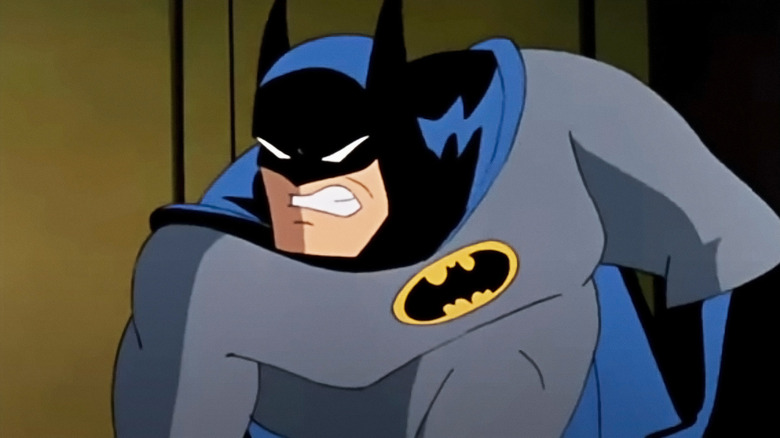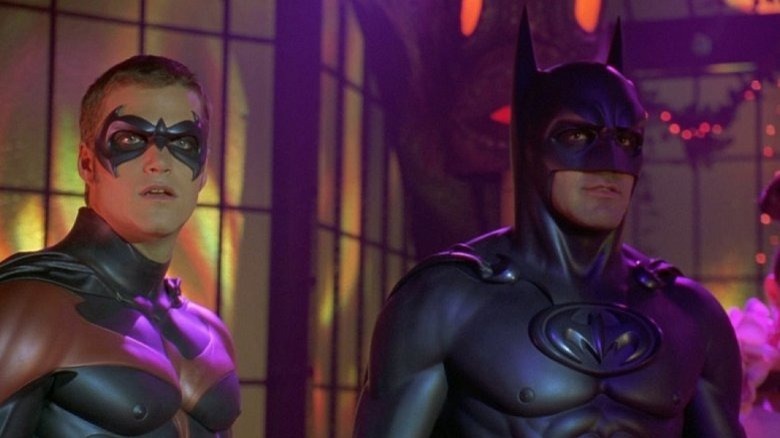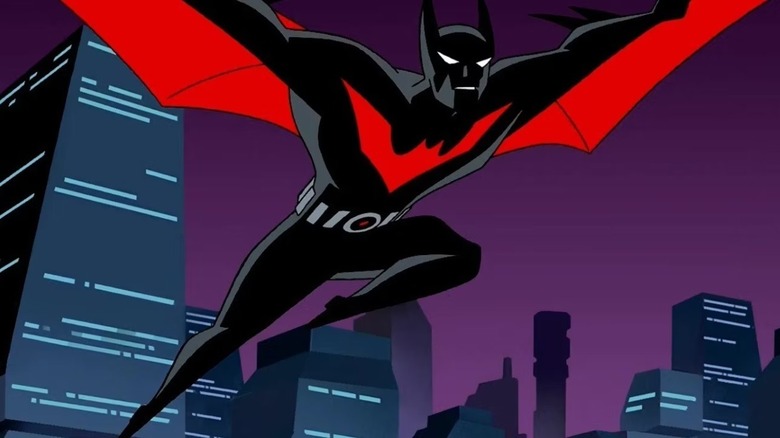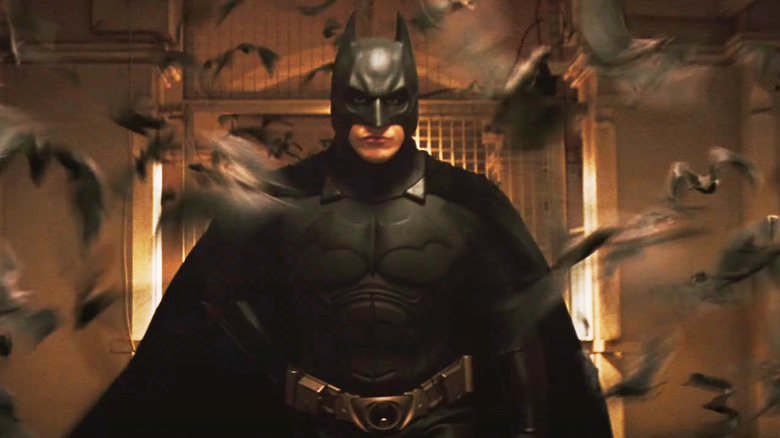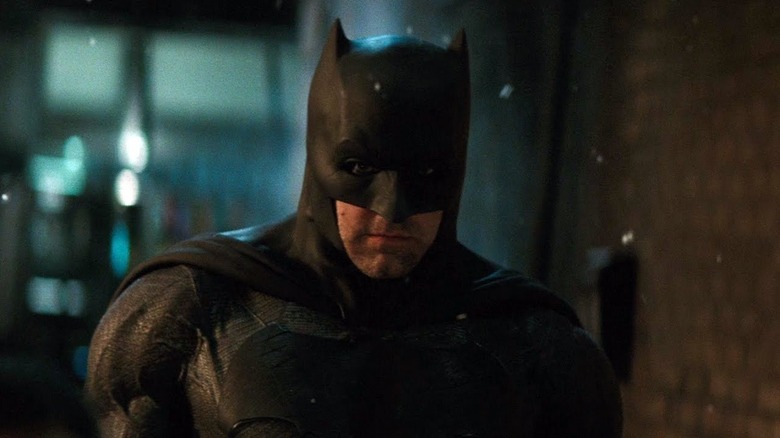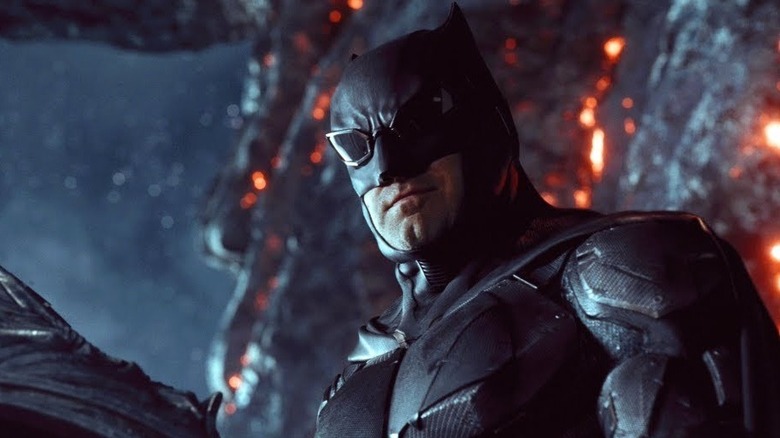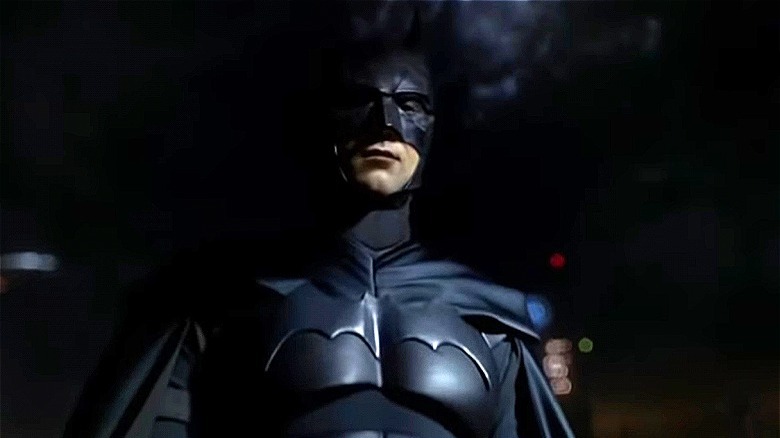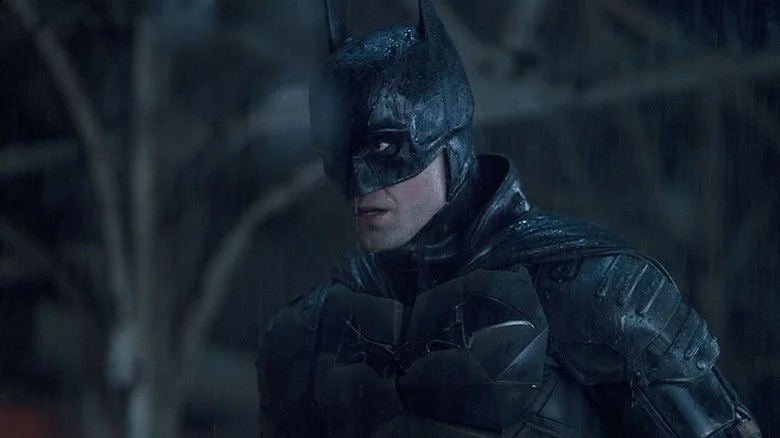The Evolution Of Batman's Batsuit: From 1939 To Present Day
Remember 1995's "Clueless" when Cher Horowitz wakes up and picks out her day's outfit on her computer? Batman does something similar on a daily basis. Since the character's debut in 1939, he has had a host of different looks to choose from. He's able to take a stroll through the Batcave and select the appropriate Batsuit for the night's activities. Some of the getups feature stylish accents and are made of a charming combination of Kevlar and synthetic materials, while other shocking designs had Anna Wintour heaving when she saw pictures of them. Fashion evolves and changes, though, since last decade's decadent and daring haute couture is this year's faux pas.
With a billionaire's budget, Batsy has the opportunity to experiment with his looks. Whereas the general argument around Superman is if he needs the red underpants or not, the Dark Knight continues to mix it up by changing his cowl, cape, and the shape of the symbol on his chest. Every iteration of his costume looks different from before, as he creates the ultimate lookbook.
Well, the fashion police are certainly far more reliable and efficient than those stooges at the GCPD and have kindly provided the files on Batman's most iconic Batsuits for further analysis. So let's take a look at the evolution of the Batsuit and the most integral designs from his debut to the current era.
The original Batsuit
In 1939, "Detective Comics" #27 — by Bob Kane and Bill Finger — introduced a new character called the Bat-Man. This masked crimefighter from Gotham City had a unique getup for the era. He wore a light gray shirt and pants with a black bat symbol splashed across the chest. His gloves, boots, underpants worn over his pants, cape, and cowl were all a velvety shade of blue that turned black in the right lighting. Breaking up the dark palettes was a dazzling yellow utility belt where he kept all his goodies such as his smoke grenades and chewing gum for his rendezvous with Catwoman.
However, it's this Batsuit's ears that have become the biggest talking point. Rather than point straight up from the top of his head like others, they almost seem to wrap around his head and take shape like an actual bat's. As the first costume, this Batsuit's qualities are still felt to this day as many artists borrow elements from the original design and update them for current times. In fact, there is also a subsection of the fandom that would prefer the Caped Crusader to stick to the blue and gray motif rather than the all-black attire.
The Caped Crusader's first live-action Batsuit
Most people believe the 1966 "Batman" TV show, starring Adam West as the titular hero, was the character's first foray into the live-action realm. However, there was an earlier "Batman" serial that debuted in 1943, featuring Lewis Wilson as the Caped Crusader and Douglas Croft as the Boy Wonder, Robin. Despite the strong marketing campaign for the series, "Batman" looks like a low-budget production, and it comes across in the costuming department.
Taking inspiration from the original costume that debuted in the comics, this Batsuit is a good idea in theory, but it lacked the tailor's touch in the right places and it could have applied more creative license to deviate from the source material. For example, the cowl doesn't strike fear but laughter into the hearts of criminals. Its loose fit doesn't sit well on Wilson's face at all, with the eye openings sliding around and sometimes covering the wrong section of the actor's eyes. The cowl also forms a V-shape over the actor's nose, giving the appearance of a dopey cat from "Garfield." Worst of all is the shape of ears that look more like devil horns.
The swinging sixties costume
In 1966, the Caped Crusader came to life in a colorful and wacky way. "Batman" embraces the golden era of comics in both its spirit and design — no more so than in the appearance of Adam West's iconic Batsuit. Boasting the traditional gray and blue color scheme, it's a much better-fitted outfit than the incarnations before. Additionally, the cowl is now more of a helmet, which helps it sit better on the actor's head and allows it to feature more detail. Although, the ears of this cowl are far smaller this time around than other live-action versions of the character.
In an interview with the Television Academy Foundation, West heaped praise on the show's principal costume designer, Jan Kemp, for his Batsuit design. "I worked with our wardrobe master, Jan Kemp, for a week or two before we started filming with the costume, to make sure it was really slick and that everything fit well and moved well," he said. "I thought Jan did a wonderful job." West added how the team tried their best to imitate the comic book look of the time and believed they succeeded in what they set out to do.
Tim Burton's rubbery, all-black suit
The 1980s were a pivotal time in Batman's history. Frank Miller, Klaus Janson, and Lynn Varley turned the character on its head with the release of "The Dark Knight Returns" in 1986. It signaled a darker era for the Caped Crusader, showing the potential to move away from camp and toward serious, gritty realism. While not as broody as Miller's seminal story, filmmaker Tim Burton redefined the comic book movie landscape with the release of "Batman," starring Michael Keaton as the Dark Knight, in 1989.
Combining Burton's love for German expressionism with an always-Halloween aesthetic, this film is visually unique and it comes across in the Batsuit as well. Jet-black — apart from the yellow insignia holding the bat symbol on the chest — rubbery and chiseled with muscle definition, Keaton's outfit stands out for all the right reasons. Plus, the cowl feels like something pulled straight out of the comics with its precision, linework, and menacing ears.
For Keaton, though, the first suit he wore was a major challenge, as he explained during a press conference. He couldn't get in and out of the Batsuit, nor could he turn his head — in fact, he ripped the cowl the first time he tried to. Fortunately, the second iteration of the suit he wore in 1992's "Batman Returns" featured several improvements.
The iconic animated series look
Despite all the live-action adaptations and comic book versions of Batman, one of the most beloved versions of the character is from "Batman: The Animated Series." Not only does Kevin Conroy provide the definitive voice for the hero, and continued to do so for generations, but the show also found a way to honor the character's legacy and move him forward in his appearance.
Bruce Timm's aesthetic takes everything that worked from the original gray and blue outfit from the comics and expands on it. The cowl, for example, fits snugly over Bruce Wayne's face, while his eyes are hidden by the white lenses. Batman's gauntlets borrow from Tim Burton's movies, as they also hold the same jagged edges, which come in handy when the Caped Crusader needs to block a punch from a foe and inflict damage at the same time. The Batsuit from "Batman: The Animated Series" does receive a slight tweak in the later seasons, notably in the chest area as the yellow oval with the bat symbol inside makes way for just a bat insignia.
The Bat-nipples suit
Tim Burton's "Batman Returns" didn't impress Warner Bros. The studio expected a lot more money and wasn't impressed by the dark tone of a movie that scared away marketing partners. As a result, it decided to shake things up and hire Joel Schumacher to make the films more family-friendly. Schumacher steered away from a complete overhaul of the rubbery design of the previous suits; however, he did create more Batsuit variations in both "Batman Forever" and "Batman & Robin."
What Schumacher did do, though, is add the widely debated Bat-nipples to the suits. The filmmaker explained his decision to Vice, stating, "By the time 'Batman Forever' came around, rubber molding had become so much more advanced. So I said, let's make it anatomical and gave photos of those Greek [statues] and those incredible anatomical drawings you see in medical books. [Lead sculptor Jose Fernandez] did the nipples and when I looked at them, I thought, that's cool."
Schumacher said he never expected the backlash he received for the inclusion of the Bat-nipples. While there was a lot of noise and dissent about this design, the director expressed no regret for making the decision.
Batman Beyond's futuristic attire
As the year 2000 approached, humanity experienced a watershed moment. Many people believed the turn of the century would automatically catapult everyone into the future, and adding "2000" to anything suddenly made it ultra-modern. In reality, nothing changed. However, there were a few cool projects that developed around this period — notably the "Batman Beyond" animated series. Set in the same universe as "Batman: The Animated Series" but in a dystopian Neo-Gotham, this cyberpunk show follows Terry McGinnis (Will Friedle) as he takes on the Batman mantle while being assisted by the older Bruce Wayne (Kevin Conroy).
Since the animated show is set in the future, the Batsuit receives a radical upgrade to match the series' tone. Covered from head to toe in a black electronic exoskeleton, with only a red bat symbol on the chest, this Batman has no noticeable skin on display for criminals to aim at. Although, if he does speak, his teeth and mouth show, so someone could throw a Skittle into his mouth and cause him to choke. Despite the cartoon only lasting three seasons, "Batman Beyond" has lived on in the comics, where the suit has continued to develop and evolve.
Nolan's grounded Batsuit
When filmmaker Christopher Nolan received the keys to the Batcave, he had a lot of work on his hands. He needed to erase the cartoonish memories of the previous "Batman" films and bring a grounded realism to this world. A major part of this involved a redesign of the fabled Batsuit. The tight rubber — and Bat-nipples — made way for a suit that is both functional and protective.
Nolan's Batsuit is more like a suit of armor than simply a means to disguise his identity. It's made of Kevlar to protect Batman (Christian Bale) from bullets and other types of attacks — including dog bites. As revealed by Lucius Fox (Morgan Freeman) in "Batman Begins," it's a prototype armor that the army rejected due to the high cost of production. However, Bruce Wayne decides it's perfect for nighttime crime-fighting, so he spray-paints it black and adds a bat logo to the chest. While Nolan's Batsuit might not be as visually appealing as some of the other outfits the Dark Knight has worn past and present, there's no disputing it's probably one of the safest versions around. Still, Bale said he disliked the cape, as it kept getting in the way of his acting.
Batfleck's rugged attire
Say what you will about the DC Universe and its start-stop approach to cinematic worldbuilding, but there's no disputing that Zack Snyder's superhero designs are gorgeous. While the internet may have had a collective meltdown when Ben Affleck was announced as the new Batman, jaws dropped when Batfleck appeared on screen for the first time. Make no mistake — Snyder's Batman is the most comic book-accurate of them all.
Looking like the lovechild of "The Dark Knight Returns" and the New 52's Dark Knight, this Batsuit finds the sweet spot of respecting the source material and ensuring it translates well to a live-action film. And Snyder knew he had something special on his hands before he had even released any footage of it. Speaking to Forbes in 2014, he said, "I'm actually staring at [a photo] right now in my office. And it's just massive on my wall in my office and it's epic, let me tell you! And I'm like, 'God, I want to send this to the internet immediately.'"
If the initial suit wasn't enough, Snyder delivered a pitch-perfect rendition of the iron-armored Mech Batsuit from "The Dark Knight Returns" in "Batman v Superman: Dawn of Justice" as well.
The Nite Owl-inspired look in Justice League
Ah, "Justice League" — the Voldemort of the DCU in the sense that no one wants to mention it by name. While the theatrical version of the film is the epitome of Frankenstein's monster, it still shows off elements of Zack Snyder's original work, such as the addition of the tactical Batsuit for the final battle against the Parademons in the third act. The armored outfit looks like the natural evolution of Christopher Nolan's Batsuit, but with a more comic-friendly aesthetic.
What's most interesting about this new costume is the addition of goggles. Responding to a fan question on Vero (via ComicBook.com), Snyder explained the practical purpose of the goggles. "They allow heads-up, real-time information," he said. "Thermal night vision, you know, all that shenanigans."
Looking at the sharper design of the cowl and the goggles, the costume also gives Batman a similar look to Nite Owl from "Watchmen" — another comic book movie that Snyder helmed. Interestingly enough, the Dan Dreiberg version of Nite Owl is considered a parody of Batman in the comics, so this does feel like a nice Easter egg and homage to "Watchmen" as a whole.
Gotham's dud suit
The "Gotham" TV show tried to apply the same principle as "Smallville": To focus on the individual before they become a superhero. In "Gotham," it was all about the young Bruce Wayne's (David Mazouz) journey after his parents' deaths and James Gordon's (Ben McKenzie) adventures on the police force as both men navigate the genuine cesspool that Gotham City is with all the criminals and dodgy cops running amok. Yet both shows embraced fan service and showed Superman and Batman in costume by the end of the series.
Speaking about the costume at New York Comic Con (via Heroic Hollywood) in 2018, "Gotham" showrunner John Stephens said, "It's inspired by, if I had to compare to any one costume, I'd say it's closer to 'The Dark Knight Rises.' It's a little more metallic Bat battle-y looking rather than something like the 'Suicide [Squad]' one or the Affleck one."
Many fans were pleased to see Mazouz's Bruce finally become Batman in the final shot of the series, and "The Dark Knight" influence was certainly present; however, it's one of the weakest live-action costumes to date. If one zooms in on the image, it's clear that many corners were cut and that it doesn't have the sleekness or precision associated with most modern Batsuits.
Battinson's practical Batsuit
As soon as the Batsuit for Robert Pattinson's Batman debuted, it was evident Matt Reeves' "The Batman" was going back to the more realistic and armored feel found in Christopher Nolan's movies. Since this film takes place in the Dark Knight's second year as a crime-fighter, the suit is also slightly more worn and battered than usual. It's been put together by a version of Bruce Wayne who looks for a perfect balance between protection and intimidation from his outfit.
"The Batman" costume designer Glyn Dillon revealed to Esquire that the team took all the lessons learned from the previous Bat films into account when designing this Batsuit. They wanted to make something that was mobile and easy to wear for the actor, while also changing the look of the cowl to show off Pattinson's impressive jawline. Discussing the actual shape of the cowl, Dillon said, "I was looking at Venetian face masks, the ones worn at parties, and I liked the idea of it being very skull-like. If you look at the neck piece there's this cervical vertebrae. I wanted it to have a grim reaper feel." Additionally, the costume team made sure the shape of the ears was spiky so that Batman could choose to use them as a weapon if he needed to.
